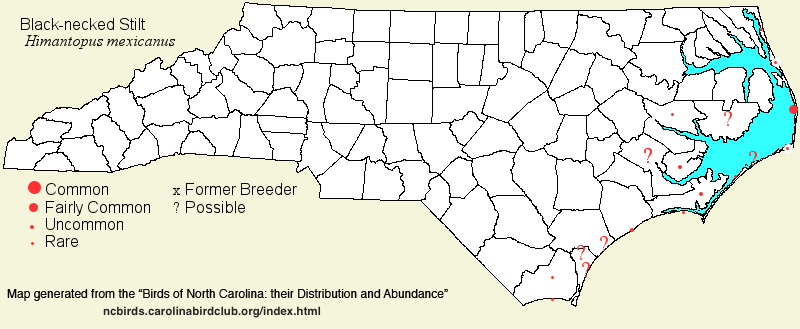 |  |
|
Black-necked Stilt - Himantopus mexicanus RECURVIROSTRIDAE Members: | Search Common: Search Scientific: |
|
|
|||||||
| General Comments | The Black-necked Stilt is one of the most unmistakable birds occurring in North Carolina, resembling no others (except members of its genus elsewhere). It has very particular requirements for nesting and foraging, and as a result, is one of the most intensely local nesting birds on the East Coast. It seldom shows up away from its few favored sites in the state; most birders see the species only in the Pea/Bodie islands area, one of the few easily accessible places to see the species. For nesting and foraging, it is restricted to fresh to brackish, still waters -- mainly impoundments, dredge spoil ponds, and sewage treatment ponds, along and close to the coast. Nearly all sites in the state are man-made bodies of water. Unlike most other shorebird species, which may straggle into late fall or early winter, stilts are quite cold intolerant, and depart the state promptly by mid-fall, though there are a handful of winter reports. This is one of the rarest shorebirds found away from the coast, with just a handful of far inland records. | ||||||
| Breeding Status | Breeder | ||||||
| NC BRC List | Definitive | ||||||
| State Status | SR | ||||||
| U.S. Status | |||||||
| State Rank | S1B | ||||||
| Global Rank | G5 | ||||||
| Coastal Plain | Summer resident and sparse migrant along the coast and in the Tidewater zone; casual to very rare in winter. A very local breeder (at only a small number of sites), but fairly common at such locales; in general, rare along most stretches of the coast, and very rare to casual in Tidewater areas. Away from coastal counties, known to nest in northeastern Pamlico and apparently in Beaufort near Aurora. Mainly mid-Apr to mid-Sep, very sparingly from late Mar to early Nov. Six winter records: one was killed on 3 Dec 1925 in Currituck; one was at Alligator River NWR, 2-4 Jan 2005; two were at Pea Island NWR on 27-28 Dec 2022; two were at Mattamuskeet NWR on the remarkable midwinter date of 8 Feb 2023; one at Pea Island NWR from 27 Jan - 3 Feb 2024; and two at Mattamuskeet NWR on 8 Dec 2023. The two seen at Pea Island on 10 Mar 2023 were probably the same individuals that were seen there in late Dec, as the species seldom migrates north until very late Mar or Apr. Perhaps the same one or two seen in recent winters at Pea Island were again found on many dates for the entire winter 2024-25. Farther inland, it is a casual stray, with records (four to five) for the Goldsboro area, in Apr, May, and Aug; one at Buckhorn Reservoir (Wilson) on 4 Aug 2020 following passage of Hurricane Isaias; and one Lake Surf (Moore) on 9 Jun 2022. Peak counts: 46, Pea Island, 15 Aug 1995 and 28 Jul 2011; 44, Eagle Island (near Wilmington), 12 Jul 1991; 38 adults on 14 June 2020 and 35 adults and one chick on 7 Jun 2020, all at Cedar Island NWR (Carteret). | ||||||
| Piedmont | Casual migrant or stray, mainly in late spring; 11 records. One was seen in Franklin on 5 Jun 2004; four were at Winston-Salem on 28 May 2010, with one remaining to 3 Jun; one was at Falls Lake, also on 28 May 2010; and a remarkable winter record was one seen at a sewage treatment plant at Lillington (Harnett) from 3-5 Jan 1988 [Chat 53:19 link]. The fifth record was one at Lake Crabtree (Wake) on 15 May 2013. Additional records are one photographed at a small pond in Mebane (Alamance) on 6 May 2014; one at Lake Crabtree on 11 May 2015; one in the Winston-Salem (Forsyth) area on 7-8 Apr 2017; one at Lake Wheeler (Wake) on 14 May 2017; a remarkable four birds photographed far inland at W. Kerr Scott Reservoir (Wilkes) on 24 Apr 2022; and one in Gaston on 4 Apr 2025. | ||||||
| Mountains | Accidental, with two records. One was seen at Hooper Lane (Henderson) on 25 Sep 2004, presumably brought there by Tropical Storm Jeanne [Chat 69:48 link]. One was seen at this same site on 31 May 2018 [Chat 82:86 link]. | ||||||
| Finding Tips |
The best -- at least most accessible -- places to see this species are the impoundments at Pea Island NWR, and at times at nearby Bodie Island (lighthouse pond), from May into mid-summer. However, they can be missed. Most other nesting sites require a boat to reach, or are on private property. *** | ||||||
| Attribution | LeGrand[2025-07-23], LeGrand[2025-05-07], LeGrand[2024-08-02] | ||||||
| NC Map Map depicts all counties with a report (transient or resident) for the species. | Click on county for list of all known species. |
| NC Breeding Season Map Map depicts assumed breeding season abundance for the species. |  |